- State Board
-
12th Standard
-

Biology
-

Computer Applications
-

Computer Science
-

Business Maths and Statistics
-

Commerce
-

Economics
-

Maths
-

Chemistry
-

Physics
-

Computer Technology
-

History
-

Accountancy
-

Tamil
-

Maths
-

Chemistry
-

Physics
-

Biology
-

Computer Science
-

Business Maths and Statistics
-

Economics
-

Commerce
-

Accountancy
-

History
-

Computer Applications
-

Computer Technology
-

English
12th Standard stateboard question papers & Study material
தமிழ் Subjects
English Subjects
-
-
11th Standard
-

Maths
-

Biology
-

உயிரியல் - தாவரவியல்
-

Economics
-

Physics
-

Chemistry
-

History
-

Business Maths and Statistics
-

Computer Science
-

Accountancy
-

Commerce
-

Computer Applications
-

Computer Technology
-

Tamil
-

Maths
-

Commerce
-

Economics
-

Biology
-

Business Maths and Statistics
-

Accountancy
-

Computer Science
-

Physics
-

Chemistry
-

Computer Applications
-

History
-

Computer Technology
-

Tamil
-

English
11th Standard stateboard question papers & Study material
தமிழ் Subjects
English Subjects
-
-
9th Standard
-

-

-

-

-

-

-

Maths
-

Science
-

Social Science
-

Maths
-

Science
-

Social Science
9th Standard stateboard question papers & Study material
தமிழ் Subjects
English Subjects
-
-
6th Standard
-

Maths
-

Science
-

Social Science
-

Maths
-

Science
-

Social Science
6th Standard stateboard question papers & Study material
தமிழ் Subjects
English Subjects
-
-
10th Standard
-

Maths
-

Science
-

Social Science
-

Tamil
-

Maths
-

Science
-

Social Science
-

English
-

English
10th Standard stateboard question papers & Study material
தமிழ் Subjects
English Subjects
-
-
7th Standard
-

Maths
-

Science
-

Maths
-

Science
-

Social Science
7th Standard stateboard question papers & Study material
தமிழ் Subjects
English Subjects
-
-
8th Standard
-

கணிதம் - old
-

Science
-

Social Science
-

கணிதம்
-

Maths
-

Science
-

Social Science
8th Standard stateboard question papers & Study material
தமிழ் Subjects
English Subjects
-
-
12th Standard
- CBSE Board
-
12th Standard CBSE
-

Biology
-

Chemistry
-

Physics
-

Maths
-

Accountancy
-

Business Studies
-

Economics
-

Introductory Micro and Macroeconomics
-

Computer Science
-

Geography
-

English
-

History
-

Indian Society
-

Physical Education
-

Sociology
-

Political Science
-

Engineering Graphics
-

Bio Technology
-

Entrepreneurship
-

Hindi Elective
-

Home Science
-

Legal Studies
-

Psychology
-

Hindi Core
-

Tamil
12th Standard CBSE Subject Question Paper & Study Material
-
-
11th Standard CBSE
-

Physics
-

Mathematics
-

Chemistry
-

Biology
-

Economics
-

Business Studies
-

Accountancy
-

Computer Science
-

English
-

Geography
-

History
-

Physical Education
-

Psychology
-

Sociology
-

Bio Technology
-

Enterprenership
-

Hindi
-

Home Science
-

Political Science
-

Applied Mathematics
11th Standard CBSE Subject Question Paper & Study Material
-
- 10th Standard CBSE
-
9th Standard CBSE
-

Social Science
-

Mathematics
-

Science
-

English
-

Hindi
9th Standard CBSE Subject Question Paper & Study Material
-
-
8th Standard CBSE
-

Social Science
-

Science
-

Mathematics
-

English
8th Standard CBSE Subject Question Paper & Study Material
-
-
7th Standard CBSE
-

Social Science
-

Science
-

Mathematics
-

English
7th Standard CBSE Subject Question Paper & Study Material
-
-
6th Standard CBSE
-

Social Science
-

Science
-

Mathematics
-

English
6th Standard CBSE Subject Question Paper & Study Material
-
-
12th Standard CBSE
- Free Online Test
- News
- Study Materials
-
Students
-

Stateboard Tamil Nadu
-

CBSE Board
-

Free Online Tests
-

Educational News
-

Scholarships
-

Entrance Exams India
-

Video Materials
Study Materials , News and Scholarships
-
-
Students

12th Standard Physics English Medium - Electrostatics 2 Mark Book Back Question Paper and Answer Key 2022 - 2023 Study Materials Sep-01 , 2022
QB365 provides a detailed and simple solution for every Possible Book Back Questions in Class 12 Physics Subject - Electrostatics, English Medium. It will help Students to get more practice questions, Students can Practice these question papers in addition to score best marks.
Electrostatics 2 Mark Book Back Question Paper With Answer Key
12th Standard
-
Reg.No. :
Physics
Time :
00:30:00 Hrs
Total Marks :
82
-
Calculate the number of electrons in one coulomb of negative charge.
-
Consider the charge configuration as shown in the figure. Calculate the electric field at point A. If an electron is placed at points A, what is the acceleration experienced by this electron? (mass of the electron = 9.1 x 10-31 kg and charge of electron = −1.6 x 10-19 C)
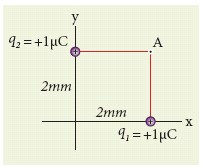
-
A block of mass m carrying a positive charge q is placed on an insulated frictionless inclined plane as shown in the figure. A uniform electric field E is applied parallel to the inclined surface such that the block is at rest. Calculate the magnitude of the electric field E.
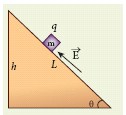
-
The following pictures depict electric field lines for various charge configurations.
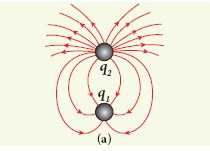
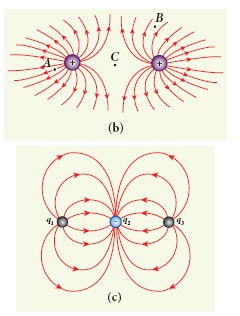
(i) In figure (a) identify the signs of two charges and find the ratio \(\left| \frac { { q }_{ 1 } }{ { q }_{ 2 } } \right| \)
(ii) In figure (b), calculate the ratio of two positive charges and identify the strength of the electric field at three points A, B, and C
(iii) Figure (c) represents the electric field lines for three charges. If q2 = -20 nC, then calculate the values of q1 and q3. -
Calculate the electric dipole moment for the following charge configurations.
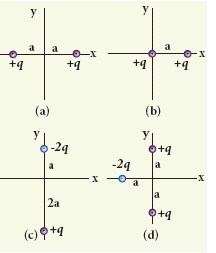
-
A sample of HCl gas is placed in a uniform electric field of magnitude 3 x 104 NC-1. The dipole moment of each HCl molecule is 3.4 x 10-30 Cm. Calculate the maximum torque experienced by each HCl molecule.
-
The following figure represents the electric potential as a function of x – coordinate. Plot the corresponding electric field as a function of x.
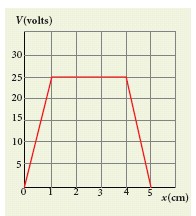
-
Four charges are arranged at the corners of the square PQRS of side an as shown in the figure.
(a) Find the work required to assemble these charges in the given configuration.
(b) Suppose a charge q is brought to the center of the square, by keeping the four charges fixed at the corners, how much extra work is required for this?
-
A water molecule has an electric dipole moment of 6.3 x 10-30 Cm. A sample contains 1022 water molecules, with all the dipole moments aligned parallel to the external electric field of magnitude 3 x 105 NC-1. How much work is required to rotate all the water molecules from θ = 0° to 90°?
-
Calculate the electric flux through the rectangle of sides 5 cm and 10 cm kept in the region of a uniform electric field 100 NC-1. The angle θ is 60°. If θ becomes zero, what is the electric flux?
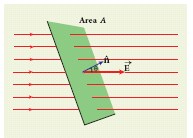
-
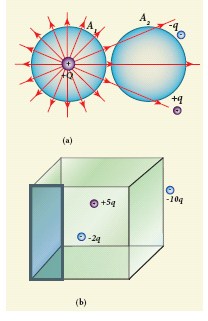
(i) In figure (a), calculate the electric flux through the closed areas A1 and A2.
(ii) In figure (b), calculate the electric flux through the cube. -
Dielectric strength of air is 3 x 106 V m-1. Suppose the radius of a hollow sphere in the Van de Graff generator is R = 0.5 m, calculate the maximum potential difference created by this Van de Graaff generator.
-
What is meant by quantisation of charges?
-
Write down Coulomb’s law in vector form and mention what each term represents.
-
Write a short note on superposition principle.
-
Define ‘electric field’
-
What is meant by ‘electric field lines’?
-
The electric field lines never intersect. Justify.
-
Define ‘electric dipole’. Give the expression for the magnitiude of its electric dipole moment and the direction.
-
Write the general definition of electric dipole moment for a collection of point charge.
-
What is an equipotential surface?
-
What are the properties of an equipotential surface?
-
Give the relation between electric field and electric potential.
-
Define ‘electrostatic potential energy’.
-
Define ‘electric flux’.
-
What is meant by electrostatic energy density?
-
Write a short note on ‘electrostatic shielding’.
-
What is polarisation?
-
What is dielectric strength?
-
Define ‘capacitance’. Give its unit.
-
What is corona discharge?
-
When two objects are rubbed with each other, approximately a charge of 50 nC can be produced in each object. Calculate the number of electrons that must be transferred to produce this charge.
-
The total number of electrons in the human body is typically in the order of 1028. Suppose, due to some reason, you and your friend lost 1% of this number of electrons. Calculate the electrostatic force between you and your friend separated at a distance of 1m. Compare this with your weight. Assume mass of each person is 60 kg and use point charge approximation.
-
Draw the free body diagram for the following charges as shown in the figure (a), (b) and (c).
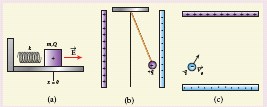
-
Consider an electron travelling with a speed vo and entering into a uniform electric field \(\vec{E}\) which is perpendicular to \(\vec { { v }_{ 0 } } \) as shown in the Figure. Ignoring gravity, obtain the electron’s acceleration, velocity and position as functions of time.
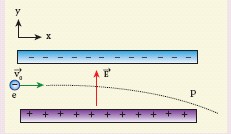
-
A closed triangular box is kept in an electric field of magnitude E = 2 x 103 NC-1 as shown in the figure.
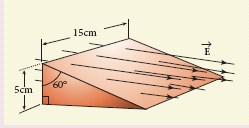
Calculate the electric flux through the
(a) vertical rectangular surface
(b) slanted surface and
(c) entire surface. -
A point charge of +10 μC is placed at a distance of 20 cm from another identical point charge of +10 μC. A point charge of -2 μC is moved from point a to b as shown in the figure. Calculate the change in potential energy of the system? Interpret your result.
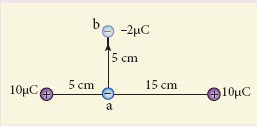
-
During a thunder storm, the movement of water molecules within the clouds creates friction, partially causing the bottom part of the clouds to become negatively charged. This implies that the bottom of the cloud and the ground act as a parallel plate capacitor. If the electric field between the cloud and ground exceeds the dielectric breakdown of the air (3 x 106 Vm-1 ), lightning will occur.
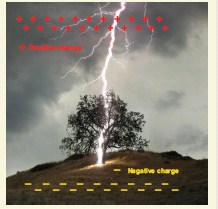
(a) If the bottom part of the cloud is 1000 m above the ground, determine the electric potential difference that exists between the cloud and ground.
(b) In a typical lightning phenomenon, around 25C of electrons are transferred from cloud to ground. How much electrostatic potential energy is transferred to the ground. -
For the given capacitor configuration
(a) Find the charges on each capacitor
(b) potential difference across them
(c) energy stored in each capacitor -
Capacitors P and Q have identical cross sectional areas A and separation d. The space between the capacitors is filled with a dielectric of dielectric constant εr as shown in the figure. Calculate the capacitance of capacitors P and Q.

-
Define ‘electrostatic potential”.
2 Marks
41 x 2 = 82






 12th Standard Physics Syllabus
12th Standard Physics Syllabus  12th Standard Physics Study Materials
12th Standard Physics Study Materials 12th Standard Physics MCQ Practise Tests
12th Standard Physics MCQ Practise Tests 

Reviews & Comments about 12th Standard Physics English Medium - Electrostatics 2 Mark Book Back Question Paper and Answer Key 2022 - 2023
Write your Comment